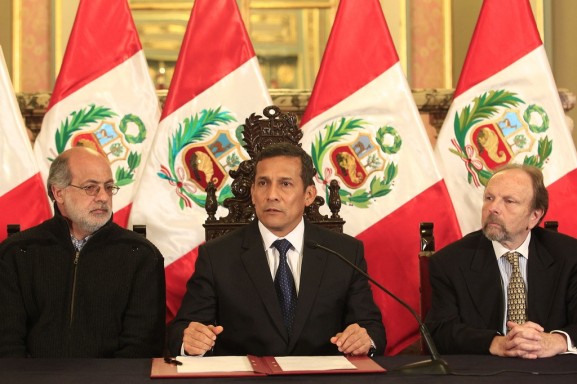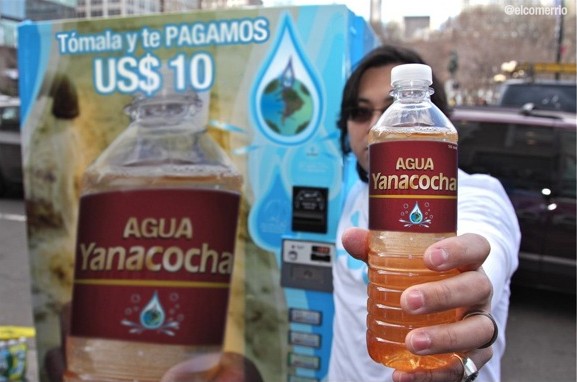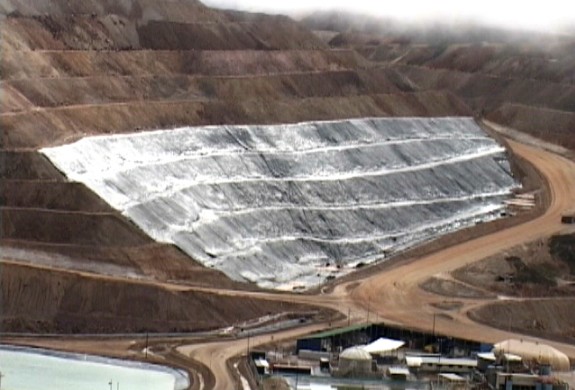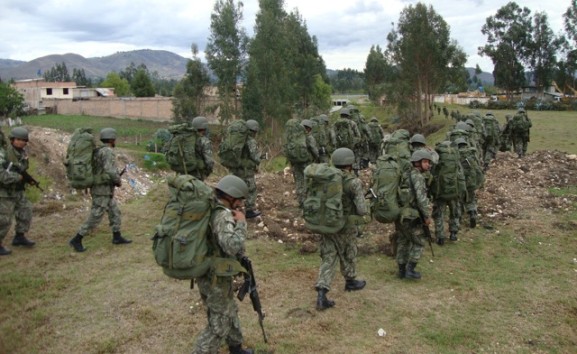Business as usual: Peru’s new president leaps to the right
 Print This Print This
By Stephanie Boyd
New Internationalist
Saturday, Dec 10, 2011
 |
| Since taking office in July, the politics of Peru's President, Ollanta Humala, have taken a worrying shift in direction. Photo by Presidencia Peru under a CC Licence. |
He promised change. He vowed that decisions about the country’s natural resources would be made by consensus and dialogue with farming and indigenous communities. He said that water was more important than gold.
In June of this year, Ollanta Humala, a former army captain, was swept to electoral victory by Peru’s majority poor: the peasant farmers, urban street vendors and Amazonian indigenous peoples.
The business community trembled. They thought Peru was heading down the scary path of social democracy. Wealth would be invested in dangerous concepts like ‘education’ and ‘healthcare’, rather than bloating the coffers of foreign companies. The hysteria reached such extremes among the middle classes that my partner’s uncle thought Humala was going to expropriate his small tourism agency.
Their fears were unfounded. Since taking power at the end of July, Humala has cast off his trademark jeans and blue work shirt, donned a suit and embraced Peru’s right wing like a long-lost friend.
His supporters are not amused.
Growing tensions in farming and indigenous communities across the country exploded in Humala’s first major crisis on 24 November when four provinces in Peru’s northern Andes declared a general strike against a proposed mine. After nine days of complete shut down, at least 17 people were wounded, including a young farmer who was paralysed by a police ‘rubber’ bullet, and Humala had declared a state of emergency, suspending civil liberties. At least three community leaders had been detained without warrant by special anti-terrorist police.
The stakes are high
The $4.8 billion Minas Conga project, located in the state of Cajamarca, would be the biggest mining investment in Peru’s history, paying $3 billion in taxes over 19 years.
There’s just one wee problem: the mineral deposit is smack in the middle of several lagoons that provide the entire farming district with water. The company says they’ll build ‘modern’ water reservoirs to replace the lakes, as though fragile natural watersheds were something you could assemble in a factory.
 |
| Gold mining has been accused of contaminating the local water supply. Photo by Grufides. |
Humala’s agricultural minister insists that the mine can co-exist with farming, but the local communities are not so easily fooled. The owners of Minas Congas, Newmont Mining of Colorado and Peru’s Buenaventura, have a long track record of environmental contamination in Cajamarca. Their Yanacocha gold mine has been accused of causing water scarcity and contaminating streams and rivers.
A decade ago the mine was responsible for a mercury spill that poisoned more than 900 people according to conservative government statistics. Locals say the real number is much higher. Villagers continue to suffer the long-term health effects: kidney and liver disease, paralysis, blindness and young people dying of mysterious illnesses.
A mining zone
Minas Congas is situated near Yanacocha, in the neighbouring province of Celendin. Together, the two projects would transform Peru’s northern Andes into a mining corridor controlled by the same owner. Regional leaders are demanding that Humala declare the project ‘unviable’ because it would destroy the area’s watershed. They want the government to consult with local communities and environmental experts to create a zoning plan for the state, marking out areas for agriculture, industry, mining and protected areas.
During the strike, more than eight thousand farmers staged a massive, 10-day sit-in at the site of the lagoons, climbing to over 4,000 meters above sea level and arriving by foot and horseback. An estimated 20,000 citizens across the state of Cajamarca took part in marches and protests, chanting ‘Water not gold’ and ‘No to Conga.’ Four provinces were effectively paralyzed during the strike, with roads blocked and schools and businesses closed.
In the provincial capital of Cajamarca, the protest took on a festive tone. Musicians paraded through the streets, artists displayed cartoons and drawings satirizing miners and politicians and many likened the atmosphere to ‘Carnaval’, the region’s popular folkloric festival each February.
People throughout the country have been captivated by the Congas cause, holding protests and roadblocks in solidarity and signing letters and petitions. Activists in the nation’s usually apathetic capital have held vigils to support the protesters and the story has dominated headlines in the national press.
Not all news is good, however, at least not for Peru’s beleaguered new president.
The mining and finance ministries are forcibly behind the project, and Humala himself declared that the project would go forward ‘yes or yes’
Humala has endured mounting criticism from Peru’s right-wing press, who accused the president of weak leadership for failing to quash the protest at the outset. Mainstream media hacks used scare tactics, referring to protesters as ‘terrorist elements’ (ie thousands of unarmed men, women and children). They warned that foreign investment would dry-up if Congas failed, the sky would fall and Peru would sink like a deflated balloon into the Pacific Ocean.
Divisions
The issue has also caused divisions within Humala’s government. Conservative elements, especially the mining and finance ministries, are forcibly behind the project, and a month ago Humala himself declared that the project would go forward ‘yes or yes.’
The Minister for the Environment, however, says the company’s Environmental Impact Assessment (EIA) is ‘seriously flawed.’
The ministry conducted an evaluation of the company’s EIA and concluded that Minas Congas would ‘significantly and irreversibly transform the watershed, destroying various ecosystems and fragmenting the rest in such a manner that the processes, functions, interactions and environmental services would be irreversibly affected.’
 |
| The Yanacocha gold mine has been accused of causing massive damage to the local environment. Photo by E. Cabellos/Guarango.
|
In a not-so-strange coincidence, the company’s EIA was approved during the former government of Alan Garcia by an ex-employee of the Yanacocha mine. (Companies must submit EIAs for approval to Peru’s Ministry for Energy and Mines before projects can go ahead).
Jose de Echave, vice-minister for the environment, resigned in protest. He said the government has no ‘strategy or clear vision for handling conflicts.’ De Echave is founder of a non-profit organization that has supported communities affected by mining for nearly two decades. His resignation was applauded by environmental groups.
Fissures continued to grow when 14 Congress Members from Humala’s own party signed a letter to express their solidarity ‘with the just struggle of the people of Cajamarca,’ and called for the immediate withdrawal of the company’s machinery and police presence.
Javier Diez Canseco, one of the Congress Members in the group, and founder of Peru’s socialist party, has been a leading critic of Humala’s flirtation with right-wing elements. In a public statement, he warned the government not to react with military force and ‘walk the razor’s edge, cutting the veins of the process of change’ and annihilating the possibility of true reform.
Several days into the strike, Yanacocha temporarily suspended work on the Minas Congas project, hoping to bring regional authorities to the negotiating table. But Cajamarca’s state governor refused to cancel the strike. He announced that there was nothing to negotiate: they want the project cancelled. End of negotiation.
Tensions escalated, the conservative press demanded action, and the strike celebrated day nine of complete shut down.
State of emergency
In a desperate attempt to save face, Humala sent a team of high level officials to Cajamarca on Sunday to negotiate with regional leaders. That same evening, the president sent shock waves through the country by enacting a state of emergency in Cajamarca. The measure gives the police carte blanche to use force against protesters and detain civilians without warrant.
 |
| Humala declared the first state of emergency in the region in over 30 years, sending troops into Cajamarca. Photo by Andres Caballeros |
In a televised statement to the nation, Humala said, ‘Every possible means has been exhausted to establish dialogue and resolve the conflict democratically … (but) not even the most basic agreements could be reached to ensure social peace and the re-establishment of public services.’
Regional leaders tell a different story. They say a government negotiating team tried to pressure them to sign an agreement, without allowing consultations with their rural supporters. According to one leader who prefers not to be named, government officials threatened to enact a state of emergency if they refused to sign.
Leaders explained that it was crucial to consult with farming leaders, who were at the root of the protest, before making major decisions, and asked for 24-hours to do so. Government negotiators refused to budge, and later that evening Humala declared the first state of emergency in the region in over 30 years.
The strong-arm move is not surprising considering Humala’s shady military past. The former captain was dismissed from the army after leading a failed coup against Alberto Fujimori (Fujimori is now serving a 25-year prison sentence for human rights abuses). A few years later Humala supported another coup attempt led by his brother against the democratically elected government of Alejandro Toledo.
But even graver accusations besmirch his record. During the country’s civil war with leftist guerrillas, Humala was in charge of an army base in Madre Mía, where he was charged with committing forced disappearances, extrajudicial executions and torture against civilians. The case against Humala was shelved, but human rights groups in Peru are not satisfied and want to see the former captain on trial.
Now, Humala is using military strategy to try to resolve social conflict. Thousands of combat soldiers are patrolling the streets and countryside of Cajamarca and three neighbouring provinces, and the emergency measure is scheduled to last 60 days. Fearing more bloodshed, local leaders called off their strike, but vowed to resume their struggle if an agreement isn’t reached in the next two months.
The state governor of Cajamarca has called on other provinces of Peru to take to the streets in peaceful protest to conserve the country’s water resources. Activists have started a movement called ‘The Grand March for Water’ and plan to continue nonviolent actions into the next year.
It’s not my fault…
Humala has tried to skirt responsibility for the Congas problem, claiming it was created by previous governments. It is true that Humala ‘inherited’ a slew of unresolved conflicts from the past government of Alan Garcia. In 2010, according to Peru’s government Ombudsman’s office, there were 246 social conflicts in the country, and nearly half of these stemmed from environmental issues related to extractive industries, such as oil, mining, gas and timber.
But these conflicts were part of the reason why the electorate voted for Humala. Tired of 20 years of neoliberal politicians, Humala’s supporters expected him to reform the country’s mining policies.
Things seemed to be starting out well. Shortly after taking power, Humala raised taxes on foreign mining companies, promising to use the extra cash to fund social programs. The government also passed the ‘Prior Consultation Law’ which stipulates that local communities must be consulted before mining, oil or gas concessions are granted on their land.
The law generated high expectations in farming communities, but analysts are more cautious about the law’s potential impact.
The past two weeks have seen the explosion of renewed conflicts throughout the country: like the strike against the Antamina y Contonga mines, protests against a proposed hydro-electric plant, and uprisings against illegal miners
Father Marco Arana, a sociologist with 20 years experience defending mining communities, says much depends on the law’s ‘regulation’, which should be published in January. In Peru, once a law is passed, a policy, or set of rules, is drawn up to determine how the legislation will be implemented.
Will the new consultation law mean that Peruvian communities will hold formal referendums before new concessions are awarded on their lands? Or will companies only require consent from local leaders? Will consent even be necessary, or will companies only have to ‘consult’ local communities, without requiring their approval?
Business leaders say the law won’t be binding, meaning that companies only have to talk to local leaders: they won’t have to respect the communities’ wishes. Certainly the government’s handling of the Conga crisis suggests that they’re not concerned with obtaining local consent before proceeding with mega-projects.
Conga isn’t the government’s only foible. The past two weeks have seen the explosion of renewed conflicts throughout the country: like the strike in Peru’s central Andes against the Antamina y Contonga mines, protests against a proposed hydro-electric plant that would dry up a major river in Cusco, and uprisings against illegal miners in the jungle region of Madre de Dios and Andahuaylas. Violent encounters between police and protesters who oppose the expansion of a jail in the state of Arequipa resulted in the death of a young protester and dozens of injured, including two police officers.
But the money keeps coming
Last week, in the middle of the Conga crisis, Peru’s political and business elite met in the former Inka capital of Cuzco for CADE, a two-day conference on the current state of Making Money in Peru: or, as a foreign business reporter told me, ‘A lot of blah, blah, blah.’
There was a lot of back slapping and lip-smacking over the country’s economic growth. Smiling government officials announced that private investment in Peru has increased 10 per cent this year. Peru ranks third in the world for copper production and is the sixth largest gold producer. Over the next five years the country is expected to receive $50 billion in natural resource investment.
No one mentioned the eight million Peruvians living in extreme poverty, on less than $1.25 a day, or the fact that the wealth isn’t tricking down to the country’s poor. The state of Cajamarca, where Congas is located, remains one of the country’s poorest regions, with 56 per cent poverty, nearly 20 years after the opening of Yanacocha, the world’s second largest gold mine.
During the conference’s gala night, a high-tech light show and fireworks lit up the outer wall of ‘Qoricancha,’ the famed Inca Temple of the Sun. During the Spanish conquest of the Americas, the invaders sacked the temple and ripped sheets of gold from the walls to melt down and send back to Europe. It seemed fitting, somehow, that organizers chose this site to celebrate the modern-day sacking of Peru’s natural resources by foreign conquerors.
Humala has the opportunity to honour his election promises and work with all sectors of Peruvian society, including indigenous and farming communities, to create a more just society.
Unfortunately, it seems that his government has decided to follow a plan of ‘business as usual’ in Peru.
Source URL
 Print This Print This

|

